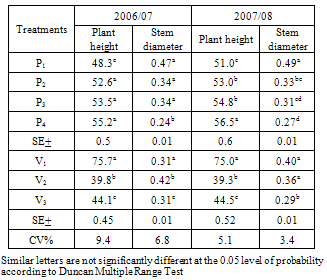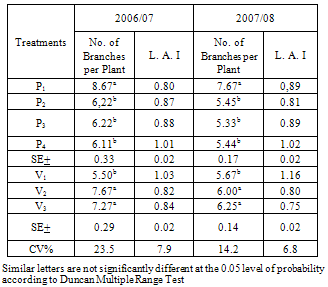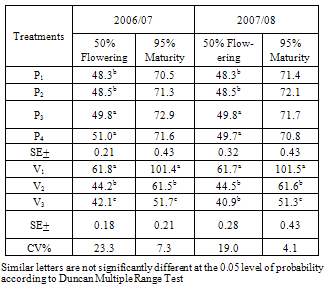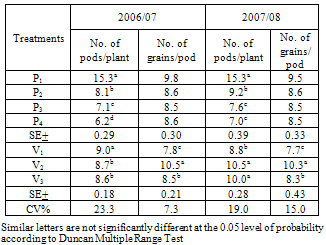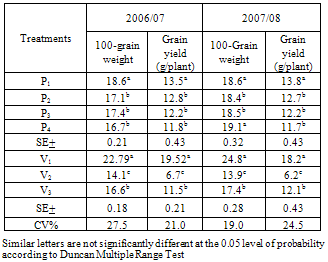-
Paper Information
- Next Paper
- Paper Submission
-
Journal Information
- About This Journal
- Editorial Board
- Current Issue
- Archive
- Author Guidelines
- Contact Us
Advances in Life Sciences
p-ISSN: 2163-1387 e-ISSN: 2163-1395
2012; 2(1): 1-5
doi: 10.5923/j.als.20120201.01
Determination of Suitable Variety and Plants per Stand of Cowpea (Vigna Unguiculata L.Walp) in the Sandy Soil, Sudan
Ahmed M. El Naim , Abdelrhim A. Jabereldar , Salaheldeen E. Ahmed , Feisal M. Ismaeil , Elshiekh A. Ibrahim
Department of Crop Sciences, Faculty of Natural Resources and Environmental Studies, University of Kordofan, Elobied, Sudan
Correspondence to: Ahmed M. El Naim , Department of Crop Sciences, Faculty of Natural Resources and Environmental Studies, University of Kordofan, Elobied, Sudan.
| Email: |  |
Copyright © 2012 Scientific & Academic Publishing. All Rights Reserved.
The study was conducted to determine the effects of four different numbers of plants per stand on the performance of three cowpea varieties under rain-fed conditions. A field experiment was conducted for two successive rainy seasons (2007/08-2008/09) in sandy soil of North Kordofan State, Sudan. The three varieties of cowpea (BLedi, an old local cultivar and two recently improved cultivars, Haydoob and Eien Elgazal) were sown in four patterns (one, two, three and four plants per stand). The experiment was laid out in a randomized complete block design (RCBD) in four replications. The results showed that, plants/stand had a significant effect on most of the attributes measured. Increased plants/stand significantly increased grain yield per unit area and reduced the number of pods per plant, 100-grain weight, grain yield per plant and harvest index. The local cultivar was late in maturity and had heavier 100-grain weight, greater grain yield per plant, greater final grain yield (t/ha). The Ein Elgazal was earlier in maturity and scored the highest values of harvest index.
Keywords: Grain Yield, Cowpea, Rain-Fed, Harvest Index
Cite this paper: Ahmed M. El Naim , Abdelrhim A. Jabereldar , Salaheldeen E. Ahmed , Feisal M. Ismaeil , Elshiekh A. Ibrahim , "Determination of Suitable Variety and Plants per Stand of Cowpea (Vigna Unguiculata L.Walp) in the Sandy Soil, Sudan", Advances in Life Sciences, Vol. 2 No. 1, 2012, pp. 1-5. doi: 10.5923/j.als.20120201.01.
1. Introduction
- Cowpea (Vigna unguiculata L.Walp.) is an ancient leguminous crop, which has been grown throughout the tropics and sub tropics. The seeds are a major source of plant proteins and vitamins for man, feed for animals, and also a source of cash income. The young leaves and immature pods are eaten as vegetables. Conservative estimates suggest that greater than 12.5 million hectares are planted annually with cowpea around the world. The total world production is estimated about 3.3 million tons of dry grain (El Naim and Jabereldar, 2010).In Sudan, cowpea is mainly grown under rain-fed conditions in Kordofan and Darfour state, which the rainfall ranged between 350 – 500 mm, only very small scattered batches had been grown under irrigation in the northern Sudan. Cowpea also plays an important role in providing soil nitrogen to cereal crops (such as maize, millet, and sorghum) when grown in rotation, especially in areas where poor soil fertility is a problem. It does not require a high rate of nitrogen fertilization; its roots have nodules in which soil bacteria called Rhizobia help to fix nitrogen from the air. Cowpea can be used as a feed (grazed, or harvested for fodder), or its pods can be harvested before maturity stage vide complementary proteins to cereals. Some people eat both fresh pods and leaves and the dried seeds are popular ingredients in various dishes. Cowpea seed contains (20 - 24%) protein, 63.3% carbohydrates and 1.9% fat (Davis, 1991).The uses of Cowpea in Sudan are diversified. The seeds can be boiled in Sudan with water and eaten as “Ballila”. They can also be cooked with meat, tomatoes and onions into a thick soup, eaten with pancake and /or bread. The paste form soaked seeds can be fried with oil as small doughnuts (Ta ammia) which can be eaten alone or with bread. Cowpea grain and fodder yields are very low in West Africa and Sudan, the main problems limiting production and expansion of cowpea as pointed out by El Naim and Jabereldar (2010) and El Naim et al. (2011) are: Low yield potential of existing cultivars, low density of cowpea and Limited use of certified seeds by the cowpea growers, due to deficient marketing and failure to convince the farmers about the advantages of planting certified seeds versus their own seeds. The research focused on detecting the suitable variety, plants per stand and evaluating the performance of the variety in the rain-fed
2. Materials and Methods
- A field experiment was conducted for two successive rainy seasons (2007/08 – 2008/09) in Kazgail area (50 km south Elobeid), in North Kordofan state (latitude 11ْ 15’ – 16 ْ 30’ N; longitude 27 ْ – 32 ْ E). The climate of the area is arid and semi arid zone. The mean annual rainfall ranges between 350 – 500 mm. The soil is sandy with low fertility. Average maximum daily temperature varied between 30 ْ and 35 ْ C throughout the year (Gebauer, 2005; El Naim and Ahmed, 2010).The experiment was laid out in a randomized complete block design with three replications. The experimental plot was 4×4meters. Treatments consisted of four levels of plants per stands one, two, three and four plants, designated as P1, P2, P3 and P4 respectively. Three varieties of cowpea: local, Hydoob and Ein Elgaza were used and designated as V1, V2 and V3 respectively. Sowing was on 25th of July, 2007 and 2008. Seeds were sown in holes at spacing of 60×30 cm, five seeds were placed in each hole, which were thinned, two weeks later, to 1, 2, 3 and 4 plants. Manual weeding was practiced twice during both seasons. A sample of four plants was taken randomly from two central rows in each experimental unit at to measure the following growth attributes: Plant height, Stem diameterNumber of branches per plant Leaf area index, Leaf area index (L.A.I) is a dimensionless quantity. It is the leaf area (upper side only) per unit area of land below. It is expressed as m2 leaf area per m2 ground area. Leaf area was determined using the punch method (Watson and Watson, 1953) by taking 50 discs and was calculated using the following relationship:-The leaf area index (L.A.I), was determined as follows:-Yield attributes: A sample of five plants was taken randomly from two central rows in each experimental unit at physiological maturity to measure the following yields attributes:Number of pods per plantNumber of grains per pods100-grain weight and Grain yield (t/ha). Harvest index was determined by using the following formula:-Data were analyzed statistically using analysis of variance according to Gomez and Gomez (1984) procedure for a randomized complete block design. The differences of means were identified by Duncan’s Multiple Range Test (DMRT) at P ≥ 0.05.
3. Results and Discussion
- Generally, increasing the plant population increased competition among plants for soil moisture, nutrient, light and carbon dioxide. Moreover, the low population plants grew as isolated units for most of their early life and interfered less with each other than at higher densities. This might explain the significant effect of plant population on most of the parameters measured in the present study. Difference in growth attributes observed among cultivars may be to the growth habit and to the genetically potential of each genotype. Increasing plant per stand decreased plant height (Table 1). Similar results were obtained by (El Naim and Jabereldar, 2010) who found plants produced at highest densities were taller and more sparsely branches. On the contrary, Mohamed (2002) reported that plant density had no significant effect on plant height. The local variety (Beldi) had significantly taller plants compared to other varieties. Differences among varieties in plant height were reported by El Naim et al (2010) and El Naim et al. (2010). Stem diameter was affected by plant population in this study (Table 2). The low plant population had a wide stem diameter compared with the high population, this may be attributed to the better soil moisture availability, decreased plant competition and increased light penetration through plant canopy at low plant population. The variation in stem diameter among cultivars might be referred to genotypic characters. Increasing plant per stand decreased number of branches per plant (Table 2). These results are in agreement with the previous findings reported by many workers (Miller, 1988; El Naim and Jabereldar, 2010; El Naim et al., 2010) .They showed that increased plant densities reduced the number of branches per plant. The local variety (Beldi) had the greatest number of branches per plant than other varieties. The leaf area index decreased with the increasing plant density (Table 2). Similar results were obtained by El Naim and Jabereldar (2010) who found that leaf area index tends to decrease with increasing plant densities. The local varieties (Beldi) had the greater leaf area index than others.
|
|
|
|
|
|
4. Conclusions
- Increased plants/stand increased grain yield (t/ha). The local cultivar (Beldi) gave the highest grain yield per unit area, but it seems to be a fodder type than grain type because it is late maturing with lowest harvest index. From the results obtained, it can be concluded that, if the crop is grown for grain yield, three plants per stand were recommended in North Kordofan State, Sudan to earn maximum yield.
 Abstract
Abstract Reference
Reference Full-Text PDF
Full-Text PDF Full-Text HTML
Full-Text HTML